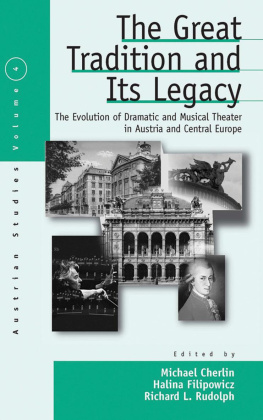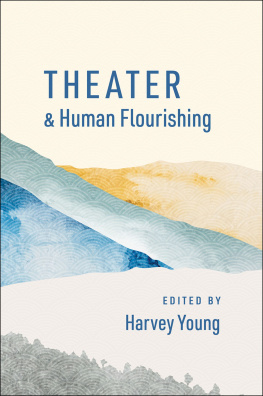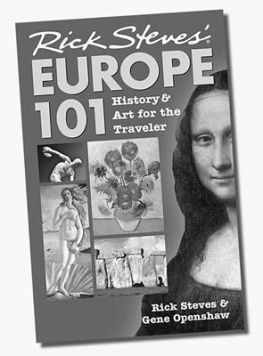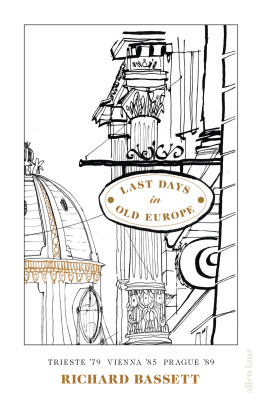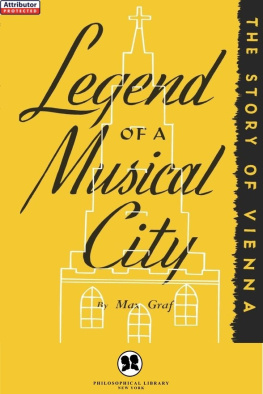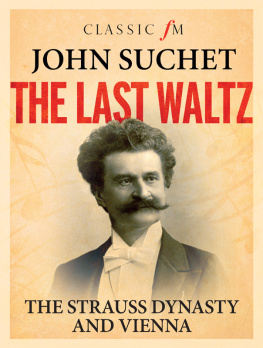THE GREAT TRADITION AND ITS LEGACY
AUSTRIAN HISTORY, CULTURE, AND SOCIETY
General Editor: Gary B. Cohen, Center for Austrian Studies, University of Minnesota
Volume 1
Austrian Women in the Nineteenth and Twentieth Centuries:
Cross-Disciplinary Perspectives
Edited by David F. Good, Margarete Grandner, and Mary Jo Maynes
Volume 2
From World War to Waldheim: Culture and Politics in Austria and the United States
Edited by David F. Good and Ruth Wodak
Volume 3
Rethinking Vienna 1900
Edited by Steven Beller
Volume 4
The Great Tradition and Its Legacy: The Evolution of Dramatic and Musical Theater in Austria and Central Europe
Edited by Michael Cherlin, Halina Filipowicz, and Richard L. Rudolph
Volume 5
Creating the Other: Ethnic Conflict and Nationalism in Habsburg Central Europe
Edited by Nancy M. Wingfield
Volume 6
Constructing Nationalities in East Central Europe
Edited by Pieter M. Judson and Marsha L. Rozenblit
THE GREAT TRADITION
AND ITS LEGACY
The Evolution of Dramatic and Musical Theater
in Austria and Central Europe
Edited by
Michael Cherlin, Halina Filipowicz,
and
Richard L. Rudolph
First published in 2003 by
Berghahn Books
www.berghahnbooks.com
First paperback edition published in 2004
2003, 2004 Michael Cherlin, Halina Filipowicz, and Richard L. Rudolph
Reprinted in 2006
All rights reserved.
Except for the quotation of short passages for the purposes of criticism and review, no part of this book may be reproduced in any form or by any means, electronic or mechanical, including photocopying, recording, or any information storage and retrieval system now known or to be invented, without written permission of the publisher.
Library of Congress Cataloging-in-Publication Data
The great tradition and its legacy : the evolution of dramatic and musical theater in Austria and Central Europe / edited by Michael Cherlin, Halina Filipowicz, and Richard L. Rudolph.
p. cm. (Austrian history, culture, and society ; v. 4)
Includes bibliographical references and index.
ISBN 1-57181-173-7 (cl.:alk.paper) ISBN 1-57181-503-4 (pbk.:alk.paper)
1. TheaterAustriaHistory. 2. Musical theaterAustriaHistory. 3. TheaterEurope, CentralHistory. 4. Musical theaterEurope, CentralHistory.
I. Cherlin, Michael. II. Filipowicz, Halina. III. Rudolph, Richard L., 1935IV. Series.
PN2611 .G65 2003
792'.09436dc21
2002028185
British Library Cataloguing in Publication Data
A catalogue record for this book is available from
the British Library.
Printed in Canada on acid-free paper
_________________
The editors of this volume gratefully acknowledge the publishers permission to reprint the following articles:
Christine Kiebuzinska, Elfriede Jelineks Nora Project: or, What Happens When Nora Meets the Capitalists, Modern Drama 41, no. 1 (1998): 13445. 1998. Modern Drama.
Jeanette R. Malkin, Pulling the Pants Off History: Politics and Postmodernism in Thomas Bernhards Eve of Retirement, Theatre Journal 47, no. 1 (1995): 10519. 1995. Johns Hopkins University Press.
Ernst Wangermann, By and By We Shall Have an Enlightened Populace: Moral Optimism and the Fine Arts in Late-Eighteenth-Century Austria, Austrian History Yearbook 30 (1999): 115. 1999. Center for Austrian Studies, University of Minnesota.
ILLUSTRATIONS
CHAPTER 11
Examples
CHAPTER 12
Examples
CHAPTER 13
Examples
CHAPTER 15
Examples
PREFACE

Both dramatic and musical theater are part of the centuries-old tradition that has made Austriaespecially Viennaand the old Habsburg lands synonymous with high culture in Central Europe. One can still readily see classical works performed today in Vienna, Prague, Budapest, or Krakw. One can also see avant-garde productions that range far and wide in experimentation and in shocking the theater-going public. In fact, as we all know, many of the works seen as classics today created great trauma in audiences upon their first presentation. This book is in part a celebration of the theatrical history of the region, but more specifically, the authors attempt to analyze the inner workings and dynamics of theater from its inception to the present, and at the same time discuss the ever important interplay between society, audience, and the creators of theatrical works. Much of the creative work done in this region, whether in music, dance, or drama, was the basis for further developments in other parts of the world, and thus is significant in general theatrical history. At the same time, much of the work was part and parcel of the social and cultural dynamics of the old monarchy and the twentieth-century Austrian republics. Although the book offers a historical panorama, it does not presume to be historically comprehensive, but rather is designed to give readers fresh insights into multiple aspects of theater in the region, and to discuss in depth the creative process and inner workings of these theatrical productions.
There are many fascinating phenomena associated with theater, as readers of this volume will soon see, but as a social historian, there is one aspect of theater that I would like to stress, which is the importance of theater in public and civil discourse. This is particularly marked in the monarchy and in Austria. In Russia, and in much of Eastern Europe, under the repressive regimes, it was the poet and writer who became the center of political discourse. There was no avenue for free public discussion, so literary journals became the arena of such discussion, both under the czars and the communists. Similarly in the old monarchy and in Austria, the rigidity of a hierarchical and authoritarian society was one of the reasons that experimentation, breaking the boundaries, and protest against authority were manifested in theatrical productions. And as the classical canon came to be embraced by the political and societal authorities, a counterpoint motif in the theater began to develop, in the form of satire, ridicule, and outright attempts to shock the established views at the most fundamental level. This shock value, from Nestroy and Mozart, through the artist Egon Schiele and the Secession, to the modern playwrights Thomas Bernhard, George Tabori and Elfriede Jelinek, all followed this tradition. This dialectic was often played out between the younger and older members of society. It was loved by those opposed to the social status quo, and hated by those who tried to conform to the respectable norms of society, but above all it made theater one of the central loci of social discourse.

